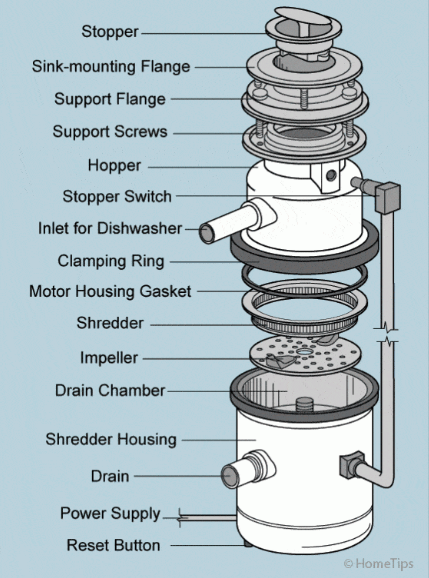In today’s rapidly evolving world of technology, gadgets have become an integral part of our lives. Whether it’s a smartphone, tablet, laptop, or any other electronic device, these gadgets eventually reach the end of their life cycle. When that time comes, many people are unsure of the best way to dispose of them. This article explores the eco-friendly approach to gadget disposal through a parts diagram, providing you with a clear understanding of how to responsibly handle these devices.
Understanding Gadget Disposal
Before delving into the intricacies of gadget disposal, it’s essential to grasp the environmental impact of improper disposal. Gadgets are made up of various components, including metals, plastics, and electronic circuitry. When discarded improperly, they contribute to electronic waste, or e-waste, which poses significant environmental hazards.
E-waste contains hazardous materials like lead, mercury, and cadmium, which can seep into the soil and water, posing risks to human health and the environment. Additionally, the energy and resources used to manufacture gadgets are wasted when they end up in landfills.
Breaking Down the Gadget
When it comes to responsible gadget disposal, the first step is understanding the device’s anatomy. Let’s break down a typical gadget into its key components to create a parts diagram that will guide us through the disposal process.
External Housing
The outer casing of a gadget is usually made of plastic or metal. Moreover it serves as protection for the internal components.
Battery
Gadgets often contain rechargeable lithium-ion batteries, which are energy-dense but require proper recycling due to their potential hazards.
Electronic Circuitry
This is the heart of the gadget, where the microchips, processors, and other electronic components are located.
Display
Most gadgets have a display screen, which can be an LCD, LED, or OLED panel.
Connectors and Ports
These include USB ports, headphone jacks, and charging ports.
Sensors
Gadgets are equipped with various sensors like accelerometers, gyroscopes, and proximity sensors.
Cameras
Many gadgets have built-in cameras for photography and video recording.
Speakers and Microphones
These components are responsible for audio input and output.
Disposing of Gadgets Responsibly
Now that we have a clear parts diagram of a gadget, it’s time to discuss the eco-friendly approach to disposal.
Battery Recycling
Lithium-ion batteries should never be thrown in the trash. Many electronics stores and recycling centers accept old batteries for proper disposal. Alternatively, some manufacturers have take-back programs for their products, ensuring that the batteries are recycled or disposed of safely.
Electronic Recycling Centers
Many localities have electronic recycling centers or designated collection events where you can drop off your old gadgets. Therefore, these centers are equipped to dismantle gadgets, recover valuable materials, and dispose of hazardous components properly.
Data Wiping
Before disposing of a gadget, it’s crucial to wipe all personal data from the device. This ensures that your sensitive information remains secure. Most gadgets have a factory reset option that erases data and restores the device to its original settings.
Component Recovery
Some components of your old gadgets may still be functional or valuable. Moreover, consider salvaging parts like screens, cameras, and speakers for potential reuse or resale. There is a growing market for refurbished gadgets and spare parts.
Donation and Trade-in Programs
If your gadget is still in working condition, consider donating it to charitable organizations or participating in manufacturer trade-in programs. Moreover, these initiatives extend the life of the device and reduce the need for new production.
Sustainable Disposal Practices
When you’ve exhausted all reuse and recycling options, ensure that the remaining parts are disposed of at a reputable facility that follows environmentally responsible practices. This includes proper disposal of hazardous materials and minimizing landfill waste.
Raise Awareness
Share your knowledge about responsible gadget disposal with friends and family. Therefore, awareness is a critical step in reducing the environmental impact of e-waste.
The Long-term Benefits of Responsible Gadget Disposal
Embracing the eco-friendly approach to gadget disposal not only benefits the environment but also has long-term advantages for society as a whole.
Conservation of Resources
Recycling and reusing gadget components reduces the need for extracting and processing raw materials. This conserves valuable resources and energy.
Reduction in Pollution
Proper disposal prevents hazardous materials from contaminating soil and water, safeguarding both the environment and human health.
Job Creation
The recycling and refurbishing industries create jobs and stimulate economic growth, contributing to a sustainable economy.
Access to Technology
Donated or refurbished gadgets can provide access to technology for underserved communities and bridge the digital divide.
Conclusion
In conclusion, in a world where gadgets are an integral part of daily life, responsible disposal is a collective responsibility. By understanding the parts of a gadget and following eco-friendly disposal practices, we can significantly reduce the environmental impact of electronic waste. Furthermore, Let’s ensure that our technological progress aligns with the principles of sustainability, making the world a cleaner and greener place for generations to come.



